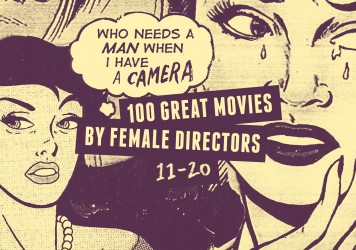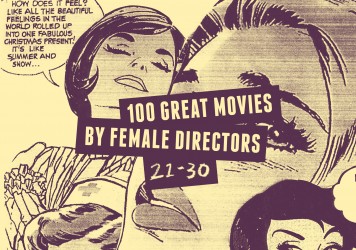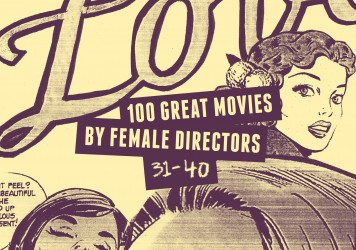
Read part one of our countdown celebrating the greatest female artists in the film industry.
For the 60th issue of Little White Lies, we sheepishly opted to ask the question: who are our favourite working female filmmakers? We capped it at 50 names, purely for reasons of resource and logistics.
The initial long list that was developed was, indeed, very long, and every name we had to expunge was like a dagger in our collective heart. We threw the selection process open to contributors, many of who suggested three or four names and, in the end, we could only really accept one or two. The filmmakers we ended up gravitating towards for the magazine edition were those who have demonstrated a relative consistency throughout their careers on one end, and on the other, slam-bang wonders who have only made one or two movies, but we’re desperate to see what they do next.
But that tactic has its downside: it meant that we were unable to laud filmmakers like Jane Campion, Carol Morley, Kasi Lemmons, Lone Scherfig, Haifaa al-Mansour and all those exceptional talents who are no longer with us. In producing this list, we too found ourselves in a process of learning, an afternoon Twitter call-out for favourite films by female directors producing a veritable cloudburst of names and titles for the research list. This is not the 100 greatest movies by female directors. It’s merely 100 movies we love and honestly think you will too.
Note: These films are presented chronologically (not ranked).
There are those who will want to physically fight you when it comes to the question of who was the first female film director. Some will stake their lives on the fact that it’s Lois Weber, others say it was the French-born Alice Guy-Blaché, who was experimenting with movie cameras right from the twilight years of the nineteenth century. Falling Leaves is a heartbreaking 12-minute miniature which captures a society ill-equipped both physically and scientifically to combat the onset and spread of disease. This beautiful parable sees a toddler attempting to prolong the life of her older sister who is battling with consumption. She does this by attempting to stop time, wandering in her front garden in the early morning and attaching the falling leaves back on the trees with string. Guy-Blaché’s film lures you into a false sense of security by initially suggesting itself as a piece of hard medical propaganda, yet the manner in which it suddenly segues into childlike wonderment is inarguably masterful. David Jenkins
Lois Weber is widely regarded as one of the first ever American female directors. She built her reputation in silent, predominantly short films and has over 100 credits as a writer, actress, and director, as well as a handful as a producer. Suspense was co-directed by Weber and her then husband, Phillips Smalley. No one ever refers to it without praising the “pioneering use of split-screen!” and we daren’t buck this trend. Clocking in at 10 minutes, Suspense effectively builds tension using tropes that would be problematic if used today. The Wife (played by Weber) is menaced by The Tramp while The Husband works late. Of course, it scans as crude to turn a homeless man into a force of evil, and Suspense is best evaluated in the same careful light as DW Griffiths’ output. Still, from the very beginning, it casts an eerie spell, peaking early as The Maid – rattled by the desolate location – writes a resignation letter and hurries off the premises. The action moves at a pace that still invigorates over 100 years later with dual action sequences knitted together with prescient storytelling technique. Sophie Monks Kaufman
It’s a common misconception that The Adventures of Prince Achmed is the first animated feature film, when in fact it’s simply the oldest one that survives. It’s easy enough to forgive the mistake, given that there were only a couple of examples that predated Lotte Reiniger and Carl Koch’s colourful riff on ‘One Thousand and One Nights’. On the other hand, how could anyone ever believe that a film so exquisitely expressive could be the first of its kind, even if that understanding is so close to the actual truth? The technique, a primitive kind of stop-motion which Reiniger invented herself, is rudimentary, but the artistry is remarkable – you can tell more about the evil magician from the crook in his neck, or about Achmed from the ruffle in his cape as he soars into the night sky on a flying horse, than can be gleaned about the Minions over 90 minutes of seamless digital chaos. The Adventures of Prince Achmed feels at once both ancient and alive, its living marionettes and shadows connecting us to the centuries that today’s popular animated fare are happy to ignore. David Ehrlich
French director Germaine Dulac’s most celebrated film is about as straightforward as Luis Buñuel’s Un Chien Andalou (which was released the subsequent year in 1929). Surrendering to surrealism and montages of feverish, eroticised and disconnected imagery is the only option. The basic premise is of a priest consumed by unpriestly fantasies in the womanly form of a general’s wife. In one sequence he pulls down her top, revealing breasts for a second before a seashell bikini pops out of nowhere to cover them. This is probably the most lucid sequence in Dulac’s experimental film that blends sharp cuts of mysterious items with lingering shots of the principle characters dashing about as if possessed. As well as being a filmmaker, Dulac was a film theorist – a pursuit she fell into after embarking on a career as a feminist journalist. SMK
Lost masterpieces are rarely as heady, harrowing and curt as Dorthy Arzner’s proto-feminist pre-code melo about a couple engaging in a ruinous ménage à trois with the demon drink. Fredric March’s wisecracking journo, Jerry, is introduced at a party, sat in the corner getting slowly soused. He is stunned into momentary sobriety by Sylvia Sidney’s canned food heiress, Joan, who falls for Jerry, because of and not despite his shambling bluster. The title suggests the worst, and the worst is what we get, as Arzner remains brutally honest about the manner in which this lopsided relationship develops. Love involves accepting someone with all their faults, but there is a tipping point, and when Joan comes up against it, her actions are surprising and progressive. It’s just 83 minutes but jam-packed with incident, though the plot-heavy approach is never to the detriment of a howling emotional credibility. As characters drink themselves into a merry stupor, one partygoer brings up the damn Depression. “What Depression?” another responds, jokingly. And there you have it. More than a screed against alcohol, this film is a plea for us remain engaged with people and with society. March is superb as the scallywag, Sidney is scintillating as the broken spouse who refuses to quietly give in to inequality. The final scenes, too, are breathtaking. Think A Farewell to Arms meets The Lost Weekend. DJ
Possibly the worst comedy ever made (and almost certainly the only film on this list executive produced by Hitler), Leni Riefenstahl’s monumental piece of Third Reich propaganda represents the birth of modern spectacle, inaugurating the era wherein images are crafted more for the benefit of the camera than they are for the live audience. Indeed, it’s hard to conceive of cinematic modernity without this ode to the 1934 Nazi Party Congress in Nuremberg, an event which doesn’t appear to be half as much fun as its title suggests. Riefenstahl’s ornamentally arranged images of the German masses have inspired everyone from Peter Jackson to Matthew Barney, but – perhaps even more importantly than its influence on The Hobbit movies – Triumph of the Will allowed the Nazis to recognise themselves on screen as a collective, which was an image empowering enough to spark an at attempt at global domination. Riefenstahl would claim that she was never aware of the Holocaust, but she certainly played a pivotal role in galvanising it. And say what you will about Hitler, but he had more faith in a woman behind the camera than do most contemporary movie studios. DE
Satisfying portrayals of the female experience of love and desire remain too few in cinema. Sugarcoating and presenting women as powerless towards their own emotions, films often fail to communicate the darker feelings that can coexist with more commercial ideas of exhilaration and fulfilment. Meshes of the Afternoon, by contrast, focuses precisely on these disturbing emotions, revealing a woman’s complexity through pure mise en scène and without forcing any given interpretation upon the spectator. Maya Deren herself goes deeper and deeper into her perplexed psyche as she considers the limited settings of a sunny street leading to a two-storey house and the evocative objects within it. She enters into it, returns to it and perceives it from a variety of angles. Although she is first following a man, the film is about his absence and the way Deren fills it with a personal reflection on her feelings for him. Duplications, transpositions and distorted camera movements coalesce to depict a woman questioning her sentiments rather than letting them rule over her. Manuela Lazic
Norway’s answer to Ingmar Bergman was a woman; Edith Carlmar to be exact. Though she worked more regularly as an actor, her 10-year directorial career proffered a bounty of exciting and passionate works which merged Hollywood standards such as noir and melodrama with a more macabre, Scandinavian sensibility and insidious undertow of depressive fatalism. Her debut feature, Death is a Caress, from 1949, suggests itself as a classic tale of murder, dames, liquor and hard love. Sonja (Bjørg Riiser-Larsen) swings her car into a local mechanic’s, only to have one of the more dashing grease monkeys, Eric (Claus Wiese), throw aside his whale sausage (!) and slide in for the romantic kill. Yet this is a flashback, as the film’s opening scene sees Eric confessing to the murder of his wife. It’s an emotionally tortuous ride, with the pair falling in and out of love with one another depending on where they are, what they’re doing and how much they’ve drunk. It’s about the chasm between love and lust, upper and lower class, freedom and captivity, working and idling, and man and woman. Calamar opts for long, intense two-shots when the couple are together, and is also adept at creative, special effect-driven transitions – the ticking clock face made of wine bottles and cocktail glasses is particularly haunting. DJ
Arguably the most famous resident of Kirkwall in the Orkney Islands, Margaret Tait dedicated much of her life to making short, lightly experimental films that were mostly inspired by the rich and rugged terrain around her. This four minutes and twenty seconds of perfection from 1952 sees Tait training her camera on her own mother who just saunters across the landscape with a cigarette permanently dangling from her bottom lip. It’s a paean to relaxation and how life can be purely defined by the connection we make to the earth, eliciting pleasure from flowers, books the wind and the light. And the simple musical accompaniment and a muttered, barely audible voice over all come together to produce a deceptively simple and nakedly moving piece of cinematic poetry. DJ
Long before John Cassavetes got to wear the t-shirt that declared him ‘The Godfather of American Independent Cinema,’ there was Ida Lupino. The Herne Hill born, RADA-trained multi-hyphenate may still be best known for her starring roles opposite Humphrey Bogart and Robert Ryan, but it’s her micro-budgeted, self-funded independent work as director-producer-screenwriter that best repays investigation. Constantly on suspension at Warners – where she was contracted – for turning down roles she considered “beneath my dignity as an actress,” she set up her own production house, The Filmakers, quietly churning out a series of issue-driven ‘women’s pictures,’ often without enough money to pay her cast and crew. There’s a consistent through-line in questions of social politics and male oppression from films like Not Wanted and Outrage to the invasion of Emmet Myers’ psychotic ‘homme fatale’ in her best known work, The Hitch-Hiker, that stamps her card with ‘Auteur’. A fierce, lean exercise in propulsive genre mechanics – and the only pure, female-directed Noir – she may have quipped, “As an actress, I’m a poor man’s Bette Davis; as a director, I’m a poor man’s Don Siegel,” but in truth, there’s no “poor-man’s” about it. Matt Thrift
Read more 100 great movies by female directors: | 11-20 | 21-30 | 31-40 | 41-50 | 51-60 | 61-70 | 71-80 | 81-90 | 91-100
Published 17 Jul 2015

Wanda and India Song feature in part two of our celebration of women filmmakers.

Read part three of our epic countdown of the greatest works by female luminaries.

From Agnès Varda to Nancy Savoca, here are 10 more must-see films from our female director countdown.